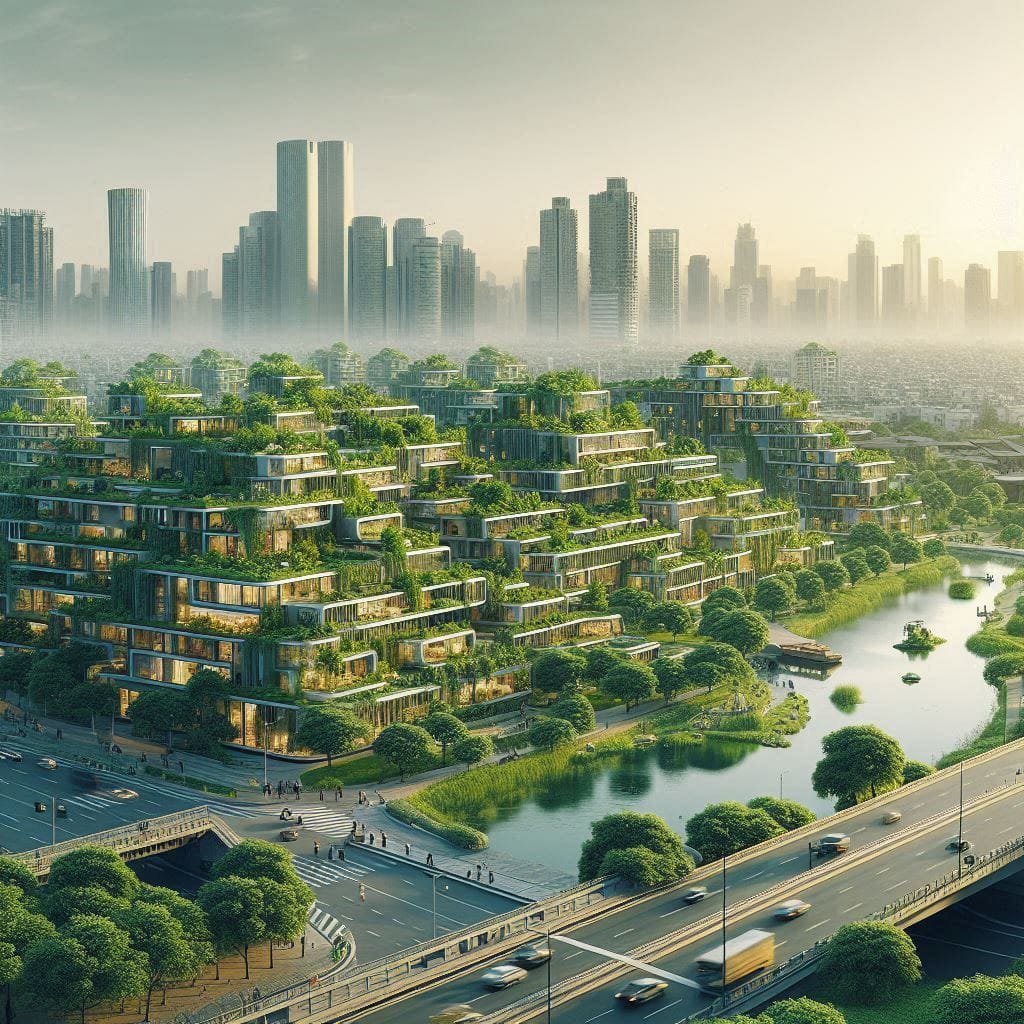India, with its rapidly growing urban population, faces significant challenges in sustainable urban planning. As cities expand, the need to balance development with environmental sustainability becomes increasingly crucial. This article explores how Indian cities are adapting to sustainable urban planning practices, highlighting successful projects and the challenges that lie ahead.
The Importance of Sustainable Urban Planning

Sustainable urban planning is vital for creating cities that can support their populations without depleting resources or harming the environment. It involves designing and managing cities in ways that promote economic growth, social inclusion, and environmental sustainability. In India, where urbanization is occurring at an unprecedented rate, sustainable planning is key to ensuring that cities remain livable and resilient.
Key Elements of Sustainable Urban Planning
- Green Infrastructure: Incorporating green spaces, such as parks, urban forests, and green roofs, into city planning to improve air quality, reduce urban heat, and enhance the quality of life for residents.
- Public Transportation: Developing efficient, low-emission public transportation systems to reduce traffic congestion and lower carbon emissions.
- Affordable Housing: Ensuring access to affordable, sustainable housing to prevent the growth of slums and promote social equity.
- Water and Waste Management: Implementing systems for sustainable water usage and waste management to conserve resources and minimize pollution.
- Energy Efficiency: Promoting energy-efficient buildings and renewable energy sources to reduce the carbon footprint of urban areas.
Successful Projects in India
- Smart Cities MissionLaunched in 2015, the Smart Cities Mission aims to develop 100 smart cities across India that prioritize sustainability. Cities like Pune, Surat, and Bhubaneswar have made significant progress in implementing smart technologies, improving public transportation, and enhancing waste management systems. For instance, Pune’s adoption of a smart traffic management system has reduced congestion and improved air quality.
- Chennai’s Rainwater Harvesting InitiativeChennai faced severe water shortages, leading to the implementation of mandatory rainwater harvesting systems across the city. This initiative has significantly improved groundwater levels and provided a reliable water source during droughts. It serves as a model for other water-stressed cities in India.
- Ahmedabad’s Bus Rapid Transit System (BRTS)Ahmedabad’s BRTS is a successful example of sustainable public transportation. Launched in 2009, it has reduced traffic congestion, cut down on travel time, and lowered carbon emissions. The BRTS model is now being replicated in other Indian cities, promoting the use of public transport over private vehicles.
- Mumbai’s Coastal Road ProjectThe Coastal Road Project in Mumbai is designed to ease traffic congestion while incorporating green spaces and pedestrian walkways. The project aims to enhance the city’s infrastructure without compromising on environmental sustainability, although it has faced challenges related to environmental clearances and public opposition.
- Indore’s Waste Management SystemIndore has been ranked as India’s cleanest city multiple times, thanks to its robust waste management system. The city’s zero-waste policy, coupled with effective waste segregation and recycling practices, has set a benchmark for other Indian cities. Indore’s success story highlights the importance of community participation and efficient governance in achieving sustainability goals.
Challenges in Sustainable Urban Planning
- Rapid UrbanizationIndia’s cities are growing at an unprecedented rate, leading to unplanned urban sprawl. This rapid expansion often outpaces the development of infrastructure and services, creating challenges for sustainable planning.
- Resource ConstraintsMany Indian cities face financial and resource constraints that hinder the implementation of sustainable projects. Limited funding, coupled with a lack of technical expertise, often delays the adoption of green technologies and practices.
- Climate ChangeClimate change poses a significant threat to urban sustainability in India. Rising temperatures, unpredictable monsoons, and increased frequency of natural disasters like floods and cyclones challenge the resilience of urban infrastructure.
- Governance and Policy ImplementationWhile policies promoting sustainable urban planning exist, their implementation remains inconsistent across cities. Corruption, bureaucratic inefficiencies, and lack of coordination among various stakeholders often lead to delays and suboptimal outcomes.
- Public Awareness and ParticipationSustainable urban planning requires the active participation of the public. However, awareness about the importance of sustainability is often low among residents. Engaging communities and encouraging them to adopt sustainable practices remains a challenge.
The Way Forward
To overcome these challenges, India needs a multi-pronged approach that includes:
- Strengthening Policy Frameworks: Ensuring that sustainable urban planning policies are comprehensive, enforceable, and adapted to local contexts.
- Capacity Building: Investing in the technical expertise of urban planners and local governments to effectively design and implement sustainable projects.
- Public-Private Partnerships: Encouraging collaborations between the government, private sector, and civil society to pool resources and drive innovation in sustainable urban planning.
- Community Engagement: Raising awareness and involving local communities in the planning process to ensure that sustainability goals align with the needs and aspirations of residents.
- Leveraging Technology: Utilizing smart technologies to monitor, manage, and optimize urban systems for better sustainability outcomes.
Conclusion
Sustainable urban planning is crucial for the future of India’s cities. While challenges remain, successful projects across the country demonstrate that sustainable development is achievable. By building on these successes and addressing the challenges, Indian cities can become models of sustainability, ensuring a better quality of life for their residents while protecting the environment for future generations.
For city planners, policymakers, and citizens alike, the path to sustainability requires concerted effort, innovation, and a commitment to change. Let’s work together to build cities that are not only economically vibrant but also environmentally resilient and socially inclusive.
#epicinfinite #epicarticle #epicblog
Have thoughts on sustainable urban planning in India? Share your insights and ideas in the comments below—let’s start a conversation!











I just wanted to express my gratitude for the valuable insights you provide through your blog. Your expertise shines through in every word, and I’m grateful for the opportunity to learn from you.
I’m truly honored that you find my blog valuable. Your positive feedback is a great motivation for me to keep sharing my knowledge. Please don’t hesitate to reach out if you have any questions or would like to discuss anything further.